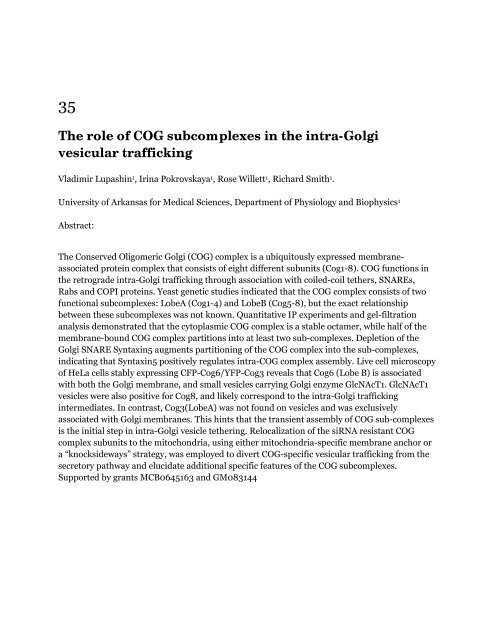View Program - asbmb
View Program - asbmb
View Program - asbmb
- TAGS
- program
- asbmb
- www.asbmb.org
You also want an ePaper? Increase the reach of your titles
YUMPU automatically turns print PDFs into web optimized ePapers that Google loves.
35<br />
The role of COG subcomplexes in the intra-Golgi<br />
vesicular trafficking<br />
Vladimir Lupashin 1 , Irina Pokrovskaya 1 , Rose Willett 1 , Richard Smith 1 .<br />
University of Arkansas for Medical Sciences, Department of Physiology and Biophysics 1<br />
Abstract:<br />
The Conserved Oligomeric Golgi (COG) complex is a ubiquitously expressed membraneassociated<br />
protein complex that consists of eight different subunits (Cog1-8). COG functions in<br />
the retrograde intra-Golgi trafficking through association with coiled-coil tethers, SNAREs,<br />
Rabs and COPI proteins. Yeast genetic studies indicated that the COG complex consists of two<br />
functional subcomplexes: LobeA (Cog1-4) and LobeB (Cog5-8), but the exact relationship<br />
between these subcomplexes was not known. Quantitative IP experiments and gel-filtration<br />
analysis demonstrated that the cytoplasmic COG complex is a stable octamer, while half of the<br />
membrane-bound COG complex partitions into at least two sub-complexes. Depletion of the<br />
Golgi SNARE Syntaxin5 augments partitioning of the COG complex into the sub-complexes,<br />
indicating that Syntaxin5 positively regulates intra-COG complex assembly. Live cell microscopy<br />
of HeLa cells stably expressing CFP-Cog6/YFP-Cog3 reveals that Cog6 (Lobe B) is associated<br />
with both the Golgi membrane, and small vesicles carrying Golgi enzyme GlcNAcT1. GlcNAcT1<br />
vesicles were also positive for Cog8, and likely correspond to the intra-Golgi trafficking<br />
intermediates. In contrast, Cog3(LobeA) was not found on vesicles and was exclusively<br />
associated with Golgi membranes. This hints that the transient assembly of COG sub-complexes<br />
is the initial step in intra-Golgi vesicle tethering. Relocalization of the siRNA resistant COG<br />
complex subunits to the mitochondria, using either mitochondria-specific membrane anchor or<br />
a “knocksideways” strategy, was employed to divert COG-specific vesicular trafficking from the<br />
secretory pathway and elucidate additional specific features of the COG subcomplexes.<br />
Supported by grants MCB0645163 and GM083144






